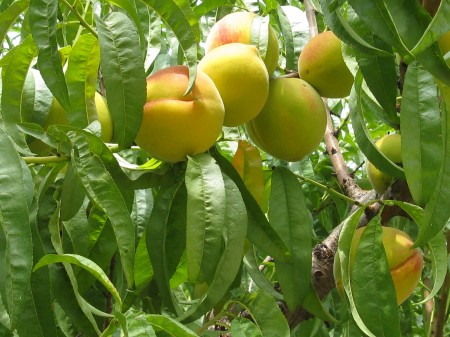Mar
25
Fruit Trees For Fuel
March 25, 2013 | 1 Comment
Fast growing trees, especially the poplars are being studied as they produce a large body of biomass per area. Poplars and willows are leading candidates as biofuel crops that are expected to produce cellulosic ethanol and higher energy content fuels when the sugars can be efficiently extracted.
We non-tree experts are going to be surprised that peaches, apples, strawberries, cherries, and almonds, and many other plants including the beautiful and romantic rose are part of the rosid superfamily. That means they share a large part of their genetic codes.
Jeremy Schmutz, head of the Plant Program at the U.S. Department of Energy Joint Genome Institute (DOE JGI) said, “The close relationship between peach and poplar trees is evident from their DNA sequence.”

This Lovell peach tree at Clemson University
provided the DNA used to determine the peach genome. Image Credit: Clemson University. Click image for the largest view.
The paper authors said, “Using comparative genomics approaches, characterization of the peach sequence can be exploited not only for the improvement and sustainability of peach and other important tree species, but also to enhance our understanding of the basic biology of trees.”
The team compared 141 peach gene families to those of six other fully sequenced diverse plant species to unravel unique metabolic pathways. They have learned for instance, what metabolic pathways lead to lignin biosynthesis – the molecular “glue” that holds the plant cells together – and is a key barrier to deconstructing biomass into fuels.
For bioenergy researchers, the size of the peach genome makes it ideal to serve as a plant model for studying genes found in related genomes, such as the poplar, and develop methods for improving plant biomass yield for biofuels.
Daniel Rokhsar, DOE JGI Eukaryotic Program head under whose leadership sequencing of the peach genome began back in 2007 takes us deeper into understanding with, “One gene we’re interested in is the so-called “evergreen” locus in peaches, which extends the growing season. In theory, it could be manipulated in poplar to increase the accumulation of biomass.”
It may not take long; the poplar is one of the DOE JGI’s Plant Flagship Genomes, making progress with poplar a first order of business.
It has seemed to be slow going. This paper’s publication comes three years after the International Peach Genome Consortium publicly released the draft assembly of the annotated peach genome on the DOE JGI Plant portal Phytozome.net and on other websites. The decision to sequence the peach genome was first announced during the 2007 Plant and Animal Genome XI Conference.
However the project goes, the long list of rosid superfamily plants is getting a huge boost of genetic information in making more productive the much loved and very important to our health tree fruits. Whether it’s for fuel for our tools or fuel for our bodies the rosid superfamly is at the start of an improvement in productivity.
Its worth mentioning that backing came from the U.S. Department of Energy Office of Science and led by researchers at the DOE JGI, The HudsonAlpha Institute for Biotechnology, Clemson University, North Carolina State University, and Washington State University. That’s peach and apple country.
Additional support was contributed by U.S. Department of Agriculture and by the Energy Biosciences Institute, of the University of California, Berkeley, who supported senior author Therese Mitros. The Italian government also supported this international effort, including the work of first author Ignazio Verde of the Fruit Tree Research Centre/Agricultural Research Council in Rome, Italy.
The scope of participants includes contributions also made from research institutes in Chile, Spain, and France. It’s definitely been an international effort.
Whatever the future holds, the genome release is going to have a powerful impact on producing important fruit foods and for fuel production. Its welcome news and a pleasure to see such a widespread participation and hopefully an even further spread out benefit to people.
Comments
1 Comment so far


working with both willow and poplar trees, i can see why they have been chosen they are vigorous in the growth department. good stuff